#basal primates
Text

Indri (Indri indri)
The stunning indri is one of the largest living lemurs. They live in the tropical forests of eastern Madagascar, and eat leaves, flowers, fruits, and seeds. They are highly social, forming monogamous pairs within larger groups. Indris have a variety of vocalisations, and often sing together. Recently, it has been discovered that indris are the only non-human mammals known to use rhythm.
54 notes
·
View notes
Text
i think nearly everything about human behavior can be explained by our evolutionary background. if we observe the entire tree of mammal phylogenetics we can see that the glires clade (rodents and lagomorphs) and euarchonta (primates, colugos and treeshrews) are grouped into one superorder called euarchontoglires, meaning humans are also technically tree dwelling mice as far as semantics are concerned. anyways there are a lot of morphological similarities one can observe between rodents and primates, namely hands, and using those hands to hold onto something like a sunflower seed or a sandwich and nibble on it while sitting in a comfortable spot. like primates the ears, hands and feet of rodents are also relatively hairless, and they are also hypersocial and studies on rats have suggested they feel empathy and will act upon it. in fact a lot of rat behavior resembles human behavior to the point that many behavioral studies are done on them in order to understand the effects/causes of addiction and isolation etc. of course all these traits developed independently but one could argue that A) the basal form that euarchontoglires originated from was already predisposed to these traits or B) already had some or all these traits in varying quantities and other groups like lagomorphs actually lost them. so the homo genus finally developing visual art as one of the culminations of animal creativity/dexterity and immediately using that skill to animate little rodent people wearing clothes and living in societies parallel to our own over and over and over and over until we are sick of seeing them and wondering wtf is going on just makes perfect sense evolutionarily speaking. it was meant to be
204 notes
·
View notes
Text

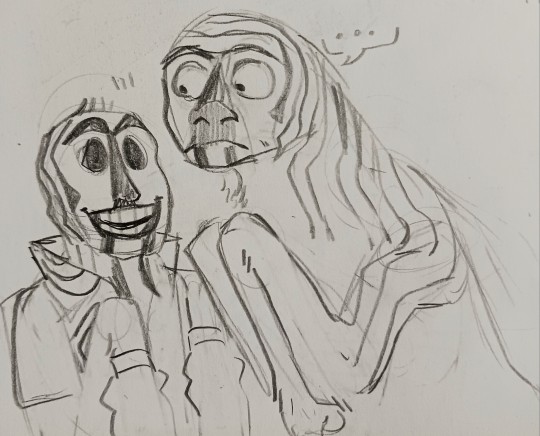
An ancestor to the Zebrapeople!
Partial stripes, mostly brown, and kind of sapient! I don't know how to explain their level of intelligence, but like... they have stone tools, but they currently can't create language, so imagine the setbacks from there. They're also mostly octopodal, and are only hexapodal for short bursts.
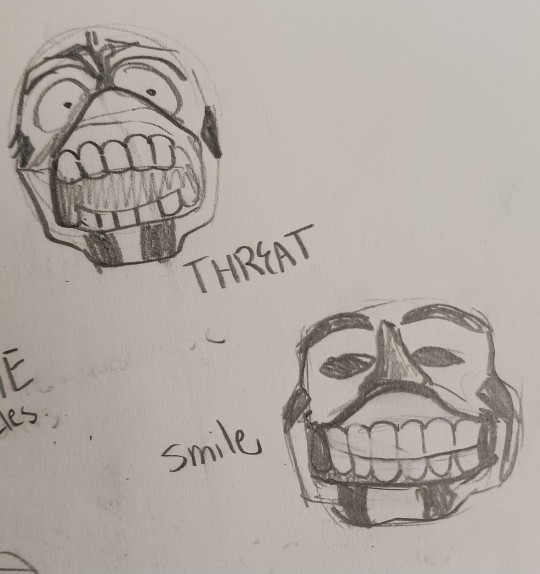
Zebrapeople actually have the facial problem that we have with the rest of their genus, where smiling is actually seen as a threat for everyone else. Or at least, the way they smile. The teeth being out bothers them, but not compared to how much the gums being exposed do.
Zebraelves evolved slightly tighter lips to have their teeth slightly out gives them a background sense of order since the baring of teeth, like in our primates, is a threat, and it also made the baring of gums a lot more dramatic. But as the species began to coagulate into one giant supercolony, the baring gums was recontextualized into the basis for most of their facial expressions.
Also; the origin of their spinnerets.

Hagfish method, baby! It's gross and works! Quagga-elves originate from a much wetter environment, so they could afford the water loss when making gross protein threads inundated with the stuff. But as they moved to more arid environments, the slime got drier and eventually was repurposed as silk... in the females.
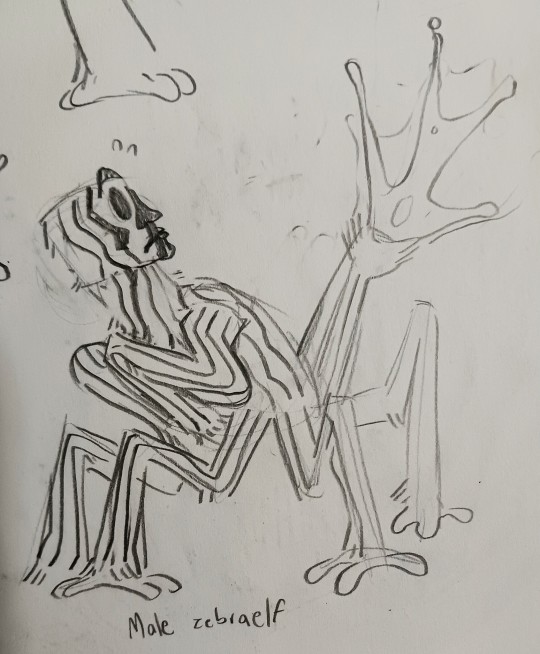
Originally, male zebraelves were supposed to have venomous spurs, but I thought it'd be better for them to still have this basal trait. Partially because they need it more!
Fraternities are a treacherous journey and male zebraelves aren't maintaining nor with their subcolony for most of the time, so it's more useful to have a gross-out factor that keeps from from being food to literally everything than to have a durable building tool/textile.
And speaking of how treacherous the journeys of fraternities are;
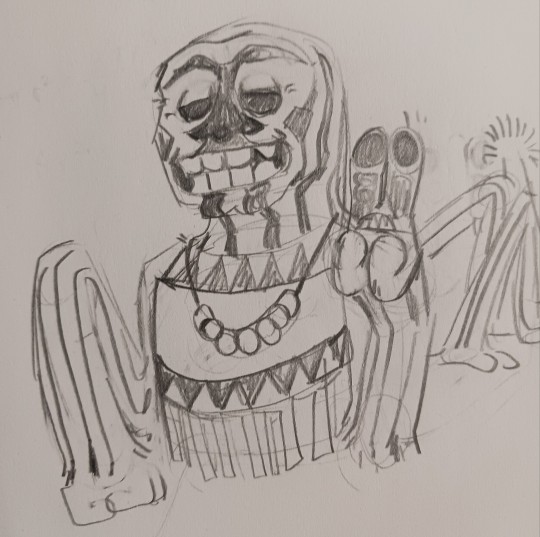
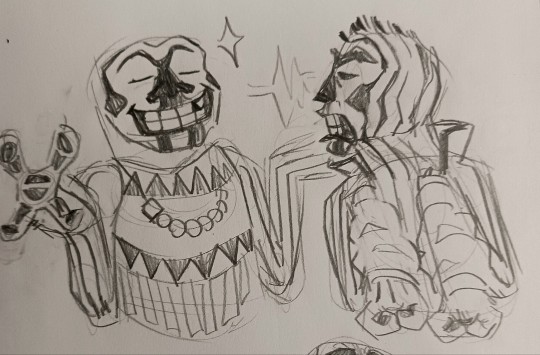
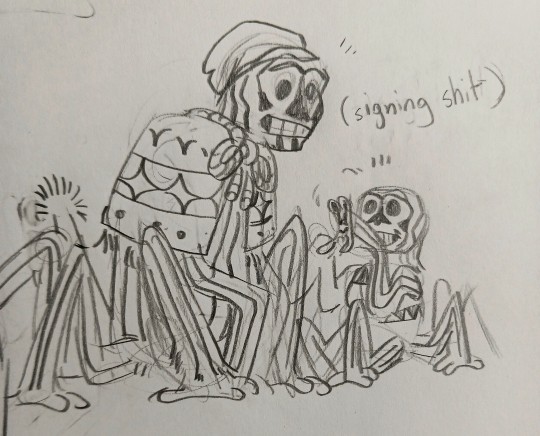
This queen's boytoy is no longer a boy, she's become a worker after losing her hearing due to getting an ear infection because disabilty accommodations in fraternities are, no hyperbole, nonexistant, for a combination of the unfriendly job environment and fucked up eugenics reasons! I really did try to avoid the kind of real life problems they have, partially because I didn't want to give fictional little guys the same societal burdens we go through, but also because if I talk about shit like music man eugenics i sound 10x more insane than I already do. unfortunately it becomes a reoccurring thing when making fictional societies.
Her relationship with the queen is looked rather down upon - neither of them care very much, especially the queen, who finally has someone she can talk to who gets it, to put it plainly. The two reproductive sexes in zebraelves are very policed, which is a rather large problem in zebraelf society.
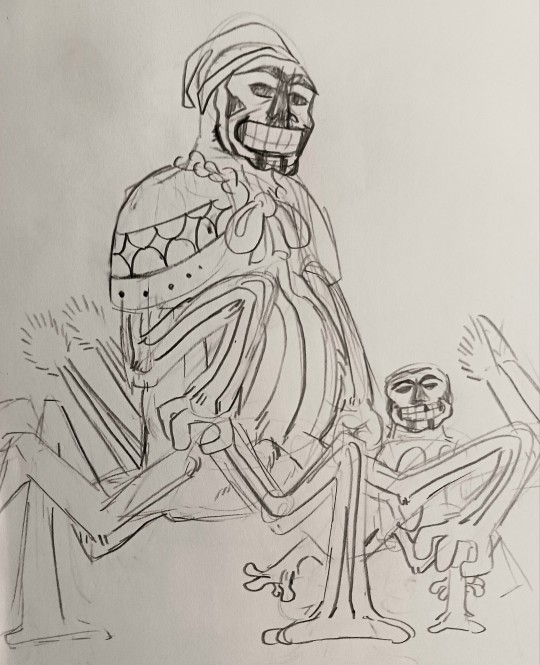
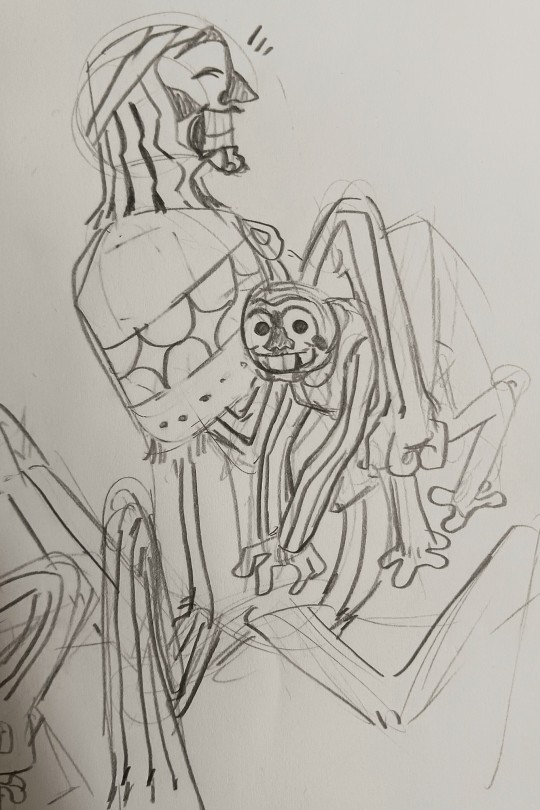
Also; Bipedal bugs! The best predator against Debu.
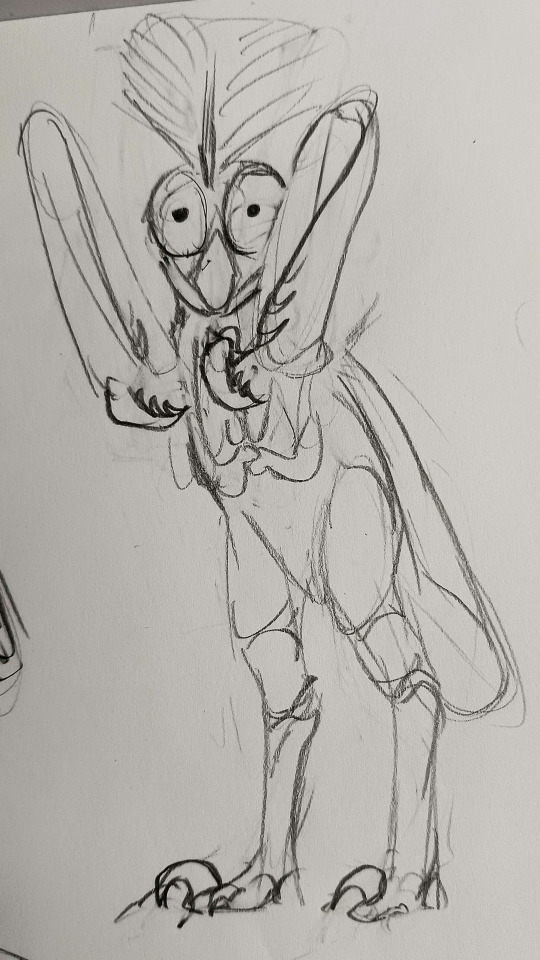
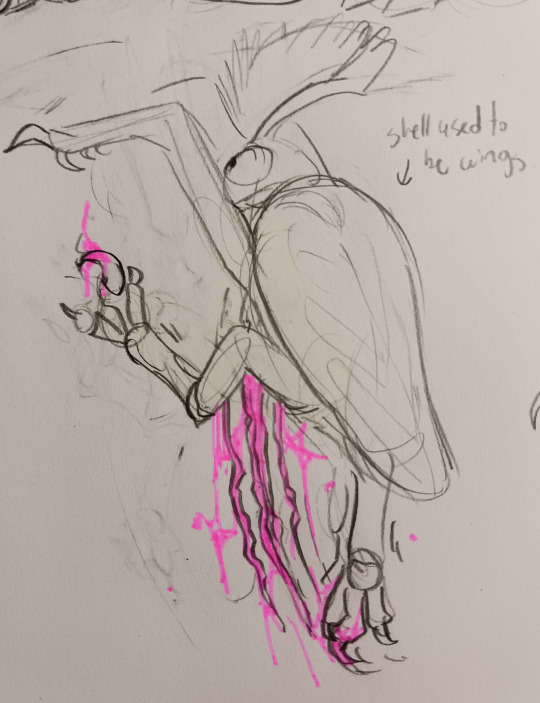
Their method is to use those two arms to latch on and just rake their sickle toe-claws against the skin as hard and fast as they can which is very effective against Debu, who, despite their brute strength, have very sensitive, weak skin! They're small, but fast, and they do a lot of damage really quickly, which is the problem, since they'll tear through already open wounds and deepen them, even leading to infection.
Sindeer often has to deal with them, since she's a large target as a lone huntress.
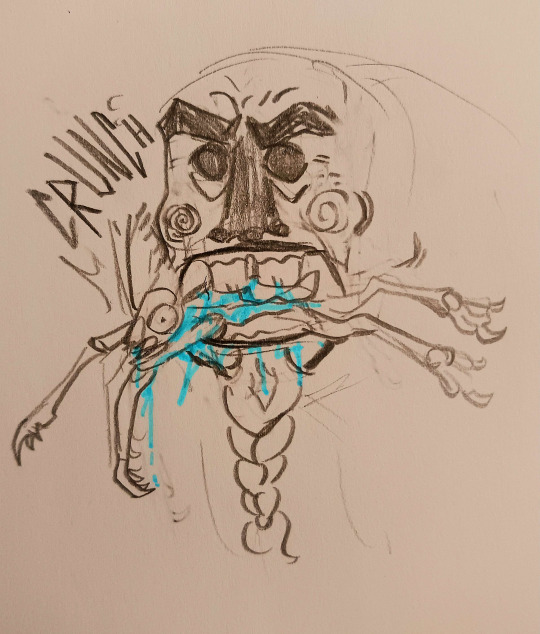
i forgot her back fur. dont look
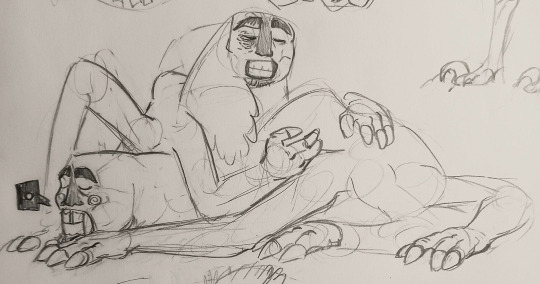
Also: today was my last day of class! Which, paradoxically, means my account is actually going to slow down? All of the almost daily music man posts are actually class doodles, and now there's going to be no more class for me to get bored in and make music man. But that means more digital artwork, which is generally higher quality, soooo???? double edged sword
#my sindeer bias is so obvious#also its interesting bc I actually had the least ideas for sindeer when I made her#I had lepit#I had rinkalla#but Sindeer was really rushed when i first designed/characterized her#i love my weird beanpole huntress lady i love her so mauch#ntls-24722#music man#music man fnaf#fnaf music man#(almost) daily music man#homo mousike#sindeer#speculative biology#speculative evolution#worldbuilding#ableism cw#ableism tw#tw ableism#cw ableism#tw eugenics#cw eugenics#eugenics cw#eugenics tw#cw blood#tw blood#blood cw#blood tw#ableism#blood
30 notes
·
View notes
Note
Please tell me more about your fantasy world I am feral for cool and unique fantasy worlds
UM UMMMMM UHHHHH well first off, everything i've posted about my world, Tacia, is in my tag #original fantasy, but it's still mostly just drawings of the sisters. (as a matter of fact, i just went back and rounded up a few straggler posts that weren't in there!)
i haven't fleshed it out all that much compared to a lot of other original fantasy worlds, but one thing i have done is set some hard-and-fast rules for the world so i can avoid having a disorganized, patchwork "kitchen sink" fantasy setting like wow or tes:
absolutely no animals past the Cretaceous-Paleogene boundary. plants are permissible, but no modern birds/fish, nothing but the most basal mammals, etc. this is why my orcs, elves, and dwarves have dinosaurian features; the humanoids are in their own clade of Dinosauria, distinct from Saurischia and Ornithischia, as there are no primates of any kind in Tacia for humans/humanoids to have evolved from.
magic requires reagent(s) and a focus to cast. this is seen in wands and staves that one has to "load" like pistols/rifles with powdered reagents, and in alchemical potions that use some solvent, carrier oil, etc. as the focus for dissolved/boiled/suspended reagents. magic cannot be cast without foci or reagents. the wood used to make wands/staves is grown on trees that are enchanted as saplings so that they aren't destroyed by the magic they channel, and the branches are shaped appropriately as they grow. more on this later once i update my sketches of this concept...
no centaurs. no satyrs. no mermaids. no ANYTHING that isn't an elf, orc, or dwarf, at least in terms of sentient species. no dragons, either. i do NOT want to open the floodgates to just throwing in random stuff that looks cool, because i don't want to exhaust myself retconning my own lore and justifying every random new thing i throw in on a whim. three species! that's it! the species are also NOT monocultural; the culture of Tacia is mixed-species with a relatively even population/distribution of each of the three.
other than that i'm mostly just winging it and doodling whatever strikes my fancy, then posting my favorite bits on here. i really don't have any grand plans for any webcomic or other project using this lore :') but i'm having a lot of fun throwing stuff in this big cauldron and seeing what happens as it cooks!
#thanks so much for asking!!!! i genuinely love being put on the spot with this project bc it helps me organize and articulate my thoughts#as opposed to the vague slurry of disconnected words and images that normally occupies my brain#shebbz shoutz#original fantasy#worldbuilding#ask
36 notes
·
View notes
Text
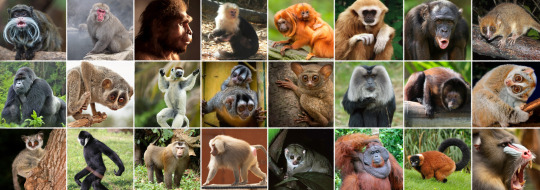
🦍The primate tournament list of candidates has been finalised! Polls will start going up soon!🦧
Thank you to everyone who submitted a species! Here is the full written list:
Basal primates (non-simian primates, including Strepsirrhini and Tarsiiformes)
†Notharctus (Notharctus tenebrosus)
Calabar angwantibo (Arctocebus calabarensis)
West African potto (Perodicticus potto)
Red slender loris (Loris tardigradus)
Bengal slow loris (Nycticebus bengalensis)
Pygmy slow loris (Xanthonycticebus pygmaeus)
Senegal bushbaby (Galago senegalensis)
Brown greater galago (Otolemur crassicaudatus)
Ring-tailed lemur (Lemur catta)
Verreaux’s sifaka (Propithecus verreauxi)
†Archaeoindris (Archaeoindris fontoynontii)
†Megaladapis (Megaladapis madagascariensis)
Madame berthe’s mouse lemur (Microcebus berthae)
Aye-aye (Daubentonia madagascariensis)
Philippine tarsier (Carlito syrichta)
Pygmy tarsier (Tarsius pumilus)
New world monkeys (Platyrrhini)
Wied’s marmoset (Callithrix kuhlii)
Goeldi’s marmoset (Callimico goeldii)
Bearded emperor tamarin (Saguinus imperator subgrisescens)
Golden-headed lion tamarin (Leontopithecus chrysomelas)
Panamanian white-faced capuchin (Cebus imitator)
Central American squirrel monkey (Saimiri oerstedii)
Gray-bellied night monkey (Aotus lemurinus)
Bald uakari (Cacajao calvus)
Madidi titi monkey (Plecturocebus aureipalatii)
Atlantic titi monkey (Callicebus personatus)
Black bearded saki (Chiropotes satanas)
White-faced saki (Pithecia pithecia)
Colombian red howler (Alouatta seniculus)
Brown spider monkey (Ateles hybridus)
Northern muriqui (Brachyteles hypoxanthus)
Yellow-tailed woolly monkey (Lagothrix flavicauda)
Old world monkeys (Cercopithecidae)
Mantled guereza (Colobus guereza)
Zanzibar red colobus (Piliocolobus kirkii)
Nepal gray langur (Semnopithecus schistaceus)
Silvery lutung (Trachypithecus cristatux)
Golden snub-nosed monkey (Rhinopithecus roxellana)
Proboscis monkey (Nasalis larvatus)
Red-shanked douc (Pygathrix nemaeus)
Collared mangabey (Cercocebus torquatus)
Japanese macaque (Macaca fuscata)
Rhesus macaque (Macaca mulatta)
Hamadryas baboon (Papio hamadryas)
Mandrill (Mandrillus sphinx)
Gelada (Theropithecus gelada)
Common patas monkey (Erythrocebus patas)
Bale mountains vervet (Chlorocebus djamdjamensis)
De brazza’s monkey (Cercopithecus neglectus)
Apes (Hominoidea)
Lar gibbon (Hylobates lar)
Pileated gibbon (Hylobates pileatus)
Kloss’s gibbon (Hylobates klossii)
Northern white-cheeked gibbon (Nomascus leucogenys)
Siamang (symphalangus syndactylus)
†Junzi (Junzi imperialis)
Bornean orangutan (Pongo pygmaeus)
†Gigantopithecus (Gigantopithecus blacki)
†Dryopithecus (Dryopithecus fontani)
Western lowland gorilla (Gorilla gorilla gorilla)
Chimpanzee (Pan troglodytes)
Bonobo (Pan paniscus)
†Australopithecus (Australopithecus afarensis)
†Panranthropus (Panranthropus boisei)
†Flores hobbit (Homo floresiensis)
†Neanderthal (Homo neanderthalensis)

The first set of polls will go up as soon as I have finished writing the descriptions! In the meantime, I would appreciate if you could share this tournament around- it won’t be much of a tournament if there aren’t that many people voting! In going down the research rabbit hole I’ve found so many interesting species and stories, and I promise learning about them here will be worth your time!
#primate bracket#tournament#tumblr tournament#poll#polls#primate#primates#extinct primates#biology#animals#zoology#please let me know if I made a mistake anywhere!
99 notes
·
View notes
Text
Interesting Papers for Week 44, 2023
Rhythmic temporal coordination of neural activity prevents representational conflict during working memory. Abdalaziz, M., Redding, Z. V., & Fiebelkorn, I. C. (2023). Current Biology, 33(9), 1855-1863.e3.
Which processes dominate visual search: Bottom-up feature contrast, top-down tuning or trial history? Becker, S. I., Grubert, A., Horstmann, G., & Ansorge, U. (2023). Cognition, 236, 105420.
Neural dynamics underlying associative learning in the dorsal and ventral hippocampus. Biane, J. S., Ladow, M. A., Stefanini, F., Boddu, S. P., Fan, A., Hassan, S., … Kheirbek, M. A. (2023). Nature Neuroscience, 26(5), 798–809.
A reservoir of foraging decision variables in the mouse brain. Cazettes, F., Mazzucato, L., Murakami, M., Morais, J. P., Augusto, E., Renart, A., & Mainen, Z. F. (2023). Nature Neuroscience, 26(5), 840–849.
Spike-phase coupling patterns reveal laminar identity in primate cortex. Davis, Z. W., Dotson, N. M., Franken, T. P., Muller, L., & Reynolds, J. H. (2023). eLife, 12, e84512.
Is all mental effort equal? The role of cognitive demand-type on effort avoidance. Embrey, J. R., Donkin, C., & Newell, B. R. (2023). Cognition, 236, 105440.
Ventral striatum dopamine release encodes unique properties of visual stimuli in mice. Gonzalez, L. S., Fisher, A. A., D’Souza, S. P., Cotella, E. M., Lang, R. A., & Robinson, J. E. (2023). eLife, 12, e85064.
Computational complexity drives sustained deliberation. Hong, T., & Stauffer, W. R. (2023). Nature Neuroscience, 26(5), 850–857.
Mathematical Model of Synaptic Long-Term Potentiation as a Bistability in a Chain of Biochemical Reactions with a Positive Feedback. Katauskis, P., Ivanauskas, F., & Alaburda, A. (2023). Acta Biotheoretica, 71(3), 16.
Geometric determinants of the postrhinal egocentric spatial map. LaChance, P. A., & Taube, J. S. (2023). Current Biology, 33(9), 1728-1743.e7.
Learning at your brain’s rhythm: individualized entrainment boosts learning for perceptual decisions. Michael, E., Covarrubias, L. S., Leong, V., & Kourtzi, Z. (2023). Cerebral Cortex, 33(9), 5382–5394.
Retinal motion statistics during natural locomotion. Muller, K. S., Matthis, J., Bonnen, K., Cormack, L. K., Huk, A. C., & Hayhoe, M. (2023). eLife, 12, e82410.
Neural dynamics and architecture of the heading direction circuit in zebrafish. Petrucco, L., Lavian, H., Wu, Y. K., Svara, F., Štih, V., & Portugues, R. (2023). Nature Neuroscience, 26(5), 765–773.
Elucidating a locus coeruleus-dentate gyrus dopamine pathway for operant reinforcement. Petter, E. A., Fallon, I. P., Hughes, R. N., Watson, G. D., Meck, W. H., Ulloa Severino, F. P., & Yin, H. H. (2023). eLife, 12, e83600.
Principles for coding associative memories in a compact neural network. Pritz, C., Itskovits, E., Bokman, E., Ruach, R., Gritsenko, V., Nelken, T., … Zaslaver, A. (2023). eLife, 12, e74434.
Critical Drift in a Neuro-Inspired Adaptive Network. Sormunen, S., Gross, T., & Saramäki, J. (2023). Physical Review Letters, 130(18), 188401.
Dopaminergic prediction errors in the ventral tegmental area reflect a multithreaded predictive model. Takahashi, Y. K., Stalnaker, T. A., Mueller, L. E., Harootonian, S. K., Langdon, A. J., & Schoenbaum, G. (2023). Nature Neuroscience, 26(5), 830–839.
Inhibitory control of sharp-wave ripple duration during learning in hippocampal recurrent networks. Vancura, B., Geiller, T., Grosmark, A., Zhao, V., & Losonczy, A. (2023). Nature Neuroscience, 26(5), 788–797.
Optogenetics reveals paradoxical network stabilizations in hippocampal CA1 and CA3. Watkins de Jong, L., Nejad, M. M., Yoon, E., Cheng, S., & Diba, K. (2023). Current Biology, 33(9), 1689-1703.e5.
The cholinergic basal forebrain provides a parallel channel for state-dependent sensory signaling to auditory cortex. Zhu, F., Elnozahy, S., Lawlor, J., & Kuchibhotla, K. V. (2023). Nature Neuroscience, 26(5), 810–819.
#neuroscience#science#research#brain science#scientific publications#cognitive science#neurobiology#cognition#psychophysics#neurons#neural computation#neural networks#computational neuroscience
18 notes
·
View notes
Text

Common Sea Monkey/Mermaid
Kingdom: Animalia
Phylum: Chordata
Class: Mammalia
Order: Primates
Suborder: Haplorhini
Infraorder: Simiiformes
Clade: Hydropithecoidea
Family: Hydropithecidae
Genus: Hydropithecus
Speices: H. ichthyophilus (“fish-loving water ape")
Ancestral species: possibly Eosimias sinensis
Temporal range: Pliocene to recent (3.0 mya - present)
Information:
Though seal-like in appearance, H. ichthyophilus, better known by the natives as *sunsaapali* and to the English-speaking world as the mermaid or common sea monkey, is, as its name suggests, not a pinniped, but rather, an aquatic primate. A member of a broader clade known as the hypdropithecoids or sea monkeys, the ancestors of this clade were likely basal simians (though its exact placement in the primate family tree cannot be determined by morphology alone since it shows a mosaic of features found in both the New World and Old World clades of monkeys, as well as features which point to a stem-simian origin) which made the transition from land to sea sometime in the late Miocene (though the common sea monkey itself is a relatively young species, with the oldest fossil material dated to around 3 million years ago in the late Pliocene). Around 10 feet in length and around 800 lbs in weight, this creature is among the larger members of its clade. Sexual dimorphism is minimal, with males being only slightly larger than females and sporting larger canines. It is also the most widely-distributed member of its clade, being found in open ocean habitats all across Archaeonesia with a total wild population of around 90,000 mature individuals, whereas most of its relatives are confined to the deep coastal waters east of the Isle of Perils. Primarily a pelagic predator, this creature’s diet is incredibly varied, going after small marine reptiles (including venomous sea snakes), a wide assortment of open ocean fish, cephalopods (including ammonites), flying sea birds, pterosaurs, and even flightless birds like penguins and some varieties of auks. This species is known to dive to the twilight zone, as far as 2,000 feet deep, in the search for food, where it hunts large deep-sea arthropods. Most of the water it needs to survive is obtained through its food. Coloration in this species is highly varied. The most common color variant is the “skipjack” one, named after its similarity to the color patterns of the skipjack tuna with its blue and white countershading. However, other color morphs exist, including a melanistic, leucistic, dark brown, light/sandy brown, “humpback” (gray and white like the whale it’s named after), mottled grey and white, and a piebald one.
A highly social and intelligent aquatic primate, the common sea monkey has a highly complex matriarchal social structure, living in family groups of up to 30 individuals. Pack-hunting is a common phenomenon and typically occurs when hunting larger prey, the younger and more limber juveniles corralling prey towards the larger and more powerful adults. Orphaned young are often cared for by other female members of the group, and young are frequently passed around from adult to adult when the respective parents of the young sea monkeys are off foraging. Though a formidable predator in its own right, it is still subject to predation from other ocean-going predators, namely whales, sharks, and large marine reptiles. To counter this, the common sea monkey uses a variety of “songs” to indicate both the identity of the predator as well as how close it is to the group. A highly vocal animal, this species communicates with a wide variety of sounds other than just “singing”. Clicking is a common vocalization, seemingly a form of echolocation as is seen in dolphins. Barking and gurgling are both used to convey aggression. This creature’s eyesight is superb, allowing it to see in pitch black seas. Like dolphins, it sleeps with one eye open and can hold its breath for hours at a time. A swift swimmer, it relies on its speed and maneuverability to escape predators, though it will attack if seemingly cornered, biting its attacker viciously. Another common way to evade predators is to spontaneously void its bowels, clouding the way with a noxious cloud of feces which both disorients its attacker and overwhelms its sense of smell. Breaching is a frequent behavior and appears to be done to swiftly grab seabirds or pterosaurs out of the air. Curious animals, they will readily approach divers and may also jump onto boats to escape predators. Some may even offer divers fish or crustaceans seemingly as a peace offering, a common gesture between sea monkey family groups.
This species mates year-round, although it occurs most frequently during November and December. The large tusks of the male are a secondary sex characteristic and are typically merely for show rather than function. The larger the tusks, the more attractive he is to females. Unusually for mammals, this species exhibits polyandry, with females having multiple mates. Gestation takes around 6 months, and the babies are born without claws or teeth to avoid injuring the mother during birth, being born feet first as well to prevent the risk of drowning during birth. Full size is reached by 2.5-3 years old and sexual maturity by 4. Young males are kicked out of the group by this period, which leads them to seek out other family groups to join, while the females typically stay with their original family group. In the wild, they can live as long as 26-30 years and in captivity, they can easily live to 34-40 years.
Though it primarily dwells in open oceans, these creatures are known to occasionally enter coastal waters and come ashore, particularly during tropical storms, which has led to a belief in many regions that these animals bring storms. Despite this association, these animals are seen rather positively by the natives. In other regions, these creatures are believed to be the reincarnated souls of sailors who died at sea. On the eastern coast, their tendency to swim alongside the outrigger canoes of the Banguani people, a culturally Polynesian minority in the region, up and down the coastline in search of food has led to a more humorous name amongst some as “Banguani sea dogs”, the idea based on the belief that the Banguani had a special association with these animals. Indeed, there is some truth to this. The Banguani people consider the common sea monkey to be the spirits of their ancestors and sometimes pay tribute to the animals by offering them some of their catches. In some areas, this species was also a historic food source, being heavily hunted in antiquity, with cave paintings all throughout the region directly depicting this. In the modern day, few people eat these animals, namely due to the fact that since they’re now known to be distantly related to humans, there is a fear of pathogens spreading from common sea monkeys to our own species, but many still hunt them for their teeth and tusks or to take their young, which are highly sought-after by aquariums and wildlife institutions abroad for their unique biology. Nicknamed the “mermaid” for its passing resemblance to the mythical creature, fringe theories suggest that a population of these creatures which escaped Archaeonesia when the border mountains crumbled back into the sea might be responsible for myths of mermaids and selkies. Interestingly, along the southern seas of the Isle of Perils, this creature is very rare, possibly due to the presence of seals and sea lions, which suggests that there may be an element of competitive exclusion between the two groups. It is sympatric with most other species in its clade, though there appears to be little interspecies competition between them, suggesting some level of niche partitioning. Remains of common sea monkeys have occasionally been found in the stomachs of giant deep-sea cephalopods, suggesting that some deep-sea creatures may prey on them. When dying, these animals are known to isolate themselves, seemingly swimming to shallow waters or nearby shorelines to die, a behavior suggested to have an evolutionary basis: by isolating themselves, the smell of their dead body will not attract predators to the larger group and therefore risk additional casualties.
#original species#novella#speculative evolution#fantasy#scifi#scififantasy#speculative biology#speculative fiction#speculative zoology#worldbuilding#creature art#sci fi#fantasy worldbuilding#fantasy creature#scifi worldbuilding#scifi creature#aquatic ape theory#sea monkey#mermaid
8 notes
·
View notes
Text




au #2, much more recent! i started drawing these last year. I wanted Scully to look like a pretty nondescript mammalian amalgamation that you couldn't pin down to any one specific creature; predator and prey traits alike. the loose implausible science fiction explanation behind her metamorphosis was that she WASN'T actually spliced with different animal genes like the usual Mad Scientist Experiment goes, rather, lots of basal mammalian traits that already existed within her human DNA were activated at random, like the Chickenosaurus project. "but no primate common ancestor in vertebrate taxonomy had horns and hooves--" Shut Up
i also knew I wanted to do some fun stuff with animalistic/feral mental states with this one, a mode she lapsed into to protect her higher human consciousness from the trauma of her ordeal--Mulder found and rescued her in this state, and wasn't ever sure for a few tense weeks if he'd even have the old Scully "back." even later, she's prone to reverting to this state if stressed and is Very Upset About This Fact
52 notes
·
View notes
Text
The Middle Temperocene: 150 million years post-establishment

Make A Munky Out Of Me: Lemunkies of the Middle Temperocene
Lemunkies, a clade of arboreal omnivores that first emerged in the Therocene and rose to greater prominence in the Temperocene, have peaked in diversity in the Middle Temperocene where tropical forests begun to spread: allowing them to dominate in the continents of Mesoterra, Arcuterra, and South Ecatoria, with an abundance of trees and tree-dwelling organisms to encourage their evolution and diversity. But in spite of their climbing origins, some unique species have begun to forsake their roots and make a foray into other, more unusual ecological niches, and with form following function, their superficial resemblance to earthly primates began to distort, often in peculiar ways.
Many of the earlier, basal forms, mostly native to the forested South Ecatoria, have retained their arboreal ways, clambering and swinging through the branches with the aid of flexible shoulders and hips, opposable grasping digits, and long flexible tails. Some, such as the glove-tailed baki (Gymnocaudus rubricephalus), have adapted their tails into prehensile appendages with a naked hairless tip capable of grasping like a fifth limb, while others, such as the white-browed goldruff (Leosimus aureus) have more rigid tails that act as counterbalances when running about in the branches, as well as being used as display signals to other members of their group, their frugivorous diet being conducive to good color fision and thus colorful intra-species displays.
In the larger members of the arboreal lemunkies, the chimpmunks, the use of a tail had become gradually less important, as their larger size and slower, more deliberate movements as opposed to a fast, scurrying gait made a counterbalance less vital, and thus their tails shrank to small nubs. They were retained by many species, such as the tuft-tailed chimpmunk (Myosimius leucacauda) as a form of display and communication among members of a clan, with the oldest and most dominant males having the whitest and most conspicuous tails. Other species however would lose them entirely, such as the leafweaver (Acaudatamys folitextoris), a species that settles in large communal nests in the trees, woven from chewed-up plant matter, and thus has no need for visual signalling as they are a highly vocal species instead, whose calls can be heard from long distances in the treetops.
But while arboreal in ancestry, many species would independently evolve into ground dwellers, either to exploit an abundance of food on the forest floor or to travel greater distances in places with sparser trees. Smaller species, such as the regal pinpine (Echinopithecus regalis) which weighs less than six kilograms at most, rely on specialized defenses to keep themselves safe from predators as they travel through Mesoterra's sparsely-forested grasslands: in the pinpine's case, sharp, bristly hairs covering its tail like fine quills that embed painfully in a predator's skin and are very difficult to remove, and which are advertised by bold, contrasting coloration warning of its defenses.
Larger ground-dwellers, however, have less to fear on the ground, with their size along being a significant deterrent to any potential attackers. Notable for such are the hamrambes of South Ecatoria, the most common of which is the orange pongongo (Zaius pongomus), which at 200 kilograms on average is no pushover to lycanines and tigerillas alike. Their social bonds and willingness to work as a group and defend the younger and weaker individuals are especially what make them very difficult prey: a single individual by itself is probably manageable to a persistent predator, but an entire troop rallying in defense is a formidable force to be reckoned with, and thus these forest-floor foragers, gentle vegetarians that are peaceful unless provoked, have little to concern them if they travel in groups.
Off the coast of Arcuterra, on the small, isolated island of Isla de Oof, however, is a species that had gone the opposite route of their kin, which had trended toward smarter and more social groups. The greater oof (Tardipithecus maximus), a descendant of the big oof from ten million years prior, is an enduring evolutionary marvel wrapped in the guise of an evolutionary failure: having a brain-to-body ratio even less than that of its ancestor the big oof, it has maximized its ability to thrive on such a nutrient-poor diet at the expense of sacrificing nearly all cognitive power except the absolute basics, and with no predators anywhere near big enough to threaten it, it has endured virtually unchanged since the time of its ancestors. About the only major difference is its preference for increased bipedalism, due to its low-level browsing slowly selecting for taller trees, and with shorter but sturdier hind legs and the use of its arms as swinging counterbalances when walking, the greater oof is granted an uncannily anthropomorphic appearance: yet not one indicative of its intelligence.
Most lemunkies are omnivorous, though lean more heavily on plant matter, occasionally supplementing their diet with insects, small rattiles and the occasional ratbat if they can catch them. One group, the moglins, in sharp contrast to their kin, have become entirely carnivorous: smaller species, such as the slender moglin (Gracilipithecomys haskinsi) are nocturnal hunters of small prey: with the aid of their large eyes and sensitive ears, they can locate small prey even in the dark. Their diet consists mostly of various invertebrates, as well as rattiles, squizzels, ratbats and other easy meals half their size or smaller. Bigger members of the moglin family, however, have a preference for equally larger quarry. The midnight howler (Noctipithecomys lugosi) is the largest of the moglins, and can weigh as much as 35 kilograms on average-- and its diet consists primarily of other species of lemunkies such as chimpmunks, which it ambushes and hunts at night: as a trade-off to their better color vision, most lemunkies have reduced eyesight at night time, an advantage the midnight howler fully exploits. Female midnight howlers are social, relying on team efforts to surround and catch their prey, which they share fairly amicably: males, on the other hand, are solitary, and often shunned by troops of females, especially during the birthing season, due to their high aggression and cannibalistic tendencies.
With arboreal, terrestrial, megafaunal, herbivorous and predatory forms, the lemunkies have radiated into a wide array of forms by the coming of the Middle Temperocene. Yet perhaps the most unexpected frontier has been also pioneered by a few unusual species: the flooded forests of the beachpeach. A species of stonefruit that adapted to coastal environments with its stilt-like roots and floating, ocean-migrating fruit, these unusual mix of ocean and jungle have only expanded with the rise of sea levels as the Middle Temperocene got warmer. This created a perfect opportunity for the sunkeys: a group of semi-aquatic lemunkies that first started diving into the water to escape predators and to feed on floating fruit. However, over the millennia, some of the sunkeys have further specialized for aquatic life, as more underwater vegetation lay waiting to be taken advantage off, in an environment too shallow and crowded for the herbivorous marine hamatees to take advantage of.
Some small species, such as the grey sunkey (Castoropithecus marinus) are still fairly great climbers as they are swimmers, still possessing gripping claws and prehensile digits in spite of their webbed digits and paddle-like tails, climbing into the trees to search for fruits and for twigs and materials to build their nests, but plunging into the water below at the first signs of danger, with their main predators being aerial ones such as falcyons and ratavults which try to try to target them from above. Other, larger species, in contrast, have basically committed themselves to the water: the merangutan (Pongosyrenus melanus) at over 300 kilograms, now has become too heavy for scaling the narrow stilt roots of the beachpeach and instead has become a specialized swimmer, with hind limbs losing their claws and becoming short, stubby paddles, while its forepaws retain them as it uses them to forage for beachpeach fruit, seagrass and other aquatic plants. While insulated mostly with a layer of fat, its fur doubles as a waterproof coat, with dense repellent guard hairs helping keep the soft underfur warm and dry. They spend nearly all their time in the water, foraging on their own, but occasionally gather ashore in groups to rest. Hauling their heavy, once-arboreal bodies ashore in a clumsy sea lion-like fashion, these gregarious gatherings are where nearly all their social interaction, such as courtship, dominance displays, and breeding takes place, otherwise which they are entirely solitary, with the exception of young who cling onto their mother's backs until they are weaned and able to swim on their own.
--------------
81 notes
·
View notes
Text
Biola: Monster Genesis character profile


Godzilla
This creature, named for the similar-looking yokai Gojira (short for gorogoro-kujira, meaning "thundering whale") of Japanese folklore, is a unique lineage of derived thyreophoran dinosaurs, branching off from basal forms such as Scelidosaurus and Jakapil kanikura, that evolved a semiaquatic marine niche as they survived into the modern day (among quite a few non-avian dinosaurs to have done so in this universe). This lifestyle enabled its housecat-to-dog-sized ancestors to become giants, with Godzilla himself standing at a towering 50 meters in height, that fed on squid, whales, giant crustaceans like Ganimes and Ebirah, and fish in deep diving ventures. They are able to stay underwater for extended periods of time due not just to holding their breath and closing a palatal valve, but due to an organ derived from an offshoot of the crop that functions as a second lung, absorbing oxygen from the water much like a turtle's cloacal respiration (water can also be reguritated from this chamber along with a mixture of previously-digested material for a defensive or aggressive display much like fulmar chicks). Additionally, like the bacteria in an anglerfish lure and firefly squid, this species has a mutual endosymbiosis with dinoflagellate algae that live within their dorsal plates, allowing them to bioluminesce for displays a feature only rivalled by their vocalizations, with the species having a language complete with legends and stories passed down from generation to generation
In the almost 70 years since this individual, the first kaiju known to mankind, made its appearance, it has been the only documented member of its species
and there's a good reason why he's the only one we've seen...
Godzilla was the top male in his particular colony. He had vibrant colors and plenty of scars to display his victories and long-held position, including a chipped beak. As one would expect from a top male, he has had plenty of offspring during his tenure, with more on the way.
until his island home was baptized by the atom.
With the atomic bomb testing, the beast that would soon be known as Godzilla was charred, scarred, and irradiated. Despite his previous radiance having been taken away from him, such scars would have been something to be proud of, as it would be shown that he was strong enough to survive this cataclysm... were he not the only survivor of this cataclysm. Indeed, He was the only one of his kind left. He was alone. He was enraged. Knowing that iron whales were present when it happened, he left his home in search of retribution and attacked the first boat he saw: the unrelated Eikō Maru. After another attack revealing Godzilla's existence to mankind and subsequent depth charges in a fruitless attempt to kill him, he then ravaged Tokyo, Japan on November 3rd, 1954. Having wreaked his vengance, he then went to rest in Tokyo Bay before being driven off from the area in Tokyo Bay in which he was resting by the Oxygen Destroyer, a device that used a catalyzed reaction to convert water and the oxygen dissolved within it into large quantities of hydrogen peroxide, irritating the beast enough to make him understand the message: "you are not welcome here."
over the next seven decades, He would resurface and be faced by either humanity or another kaiju he was interacting with, from Anguirus the following year to the primate-like Gabara in 1962 to a mysterious, orange-and-black insectoid designated as "Gigamoth" by Typhon. However, one day he found something different. Having heard a cry that was unmistakibly one of his species (albeit in an uncanny valley way), he came to the remote Odo Island where it originated, but there he found not another of his kind, but... something. This figure, like a tree with a face and arms, could only be compared by him to a spirit in his people's folklore who is split amongst all plant life; this could only be called a "Biollante". After observing the Biollante, he left, but later that night, he heard the Biollante calling to him again from the beach of Odo Island, this time more intently. After coming to this Biollante, getting to know what she was (apparently she, going by the name "Erika", was a member of the tiny things that had scorned him for many years who had also had plant essence and recently the essence of Godzilla infused into her), and taking her to hunt an Ebirah for them to share as a meal (Erika was starting to get hungry), Erika asked for the reason behind his attack on Japan all those years ago. With drawings on the sand as an aid (despite Erika being able to understand Godzilla's language in her new state, there was still a bit of a vernacular barrier betwixt the two), Godzilla found something from a human (or at least a thing that was once half human) that he had never seen from one before....
understanding.
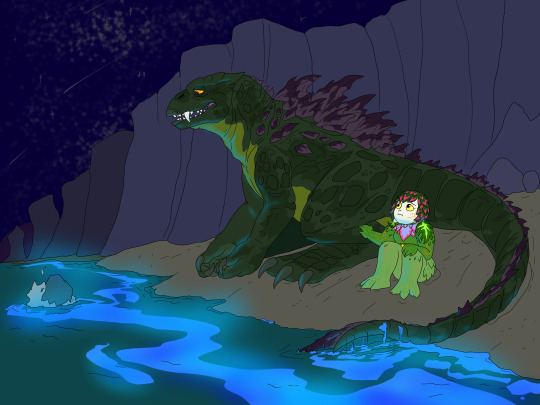
(art by @artmakerproductions)
... then, it was apparent that mankind's recklessness with scientific progress, something that made the now-irradiated dinosaur simultaneously the last of his kind and the first one like him, had inadvertently made his existence a little less lonely
4 notes
·
View notes
Text

Verreaux’s sifaka (Propithecus verreauxi)
These sifakas are very specialised for living in trees, eating mostly leaves and being capable of leaping ten metres from tree to tree. They also live in a variety of wet or dry forest habitats. Sifakas are so specialised for climbing they can’t walk on all fours like a ring-tailed lemur, nor can they stride bipedally like humans; instead, they move on the ground using an odd bipedal bounding motion.
#markhors-menagerie#primates#basal primates#lemurs#animal facts#fun facts#animals#biology#sifaka#verreaux’s sifaka
53 notes
·
View notes
Text

Who needs things like 'hand eye coordination' and 'reflexes' when your basal primate brain understands 'throw liquid at wall' and 'throw liquid above/below wall'
#⚠️THIS IS A SELF OWN I AM NOT SAYIN GTHAT YOU PERSONALLY CANNOT AIM IF YOU MAIN SLOSHERS.⚠️ ⚠️. ⚠️ ⚠️⚠️⚠️⚠️#Splatoon
15 notes
·
View notes
Note
All fox-like Pokémon and dog-like Pokémon are all apart of the Canini Similis (meaning canine like) genus, common traits include bushy tails, long snouts and upright ears, Fire, Dark and Normal types are common in this genus but there are a few exceptions to this such as the Yamper and Rockruff lines
All cat-like Pokémon are apart of the Feline Sicut (meaning feline like) genus, common traits include facial whiskers, large eyes and round faces, Normal, Fire, Psychic and Dark are common types but with a few exceptions such as the Galarian Meowth line and Umbreon
All bird-like Pokémon are in the Vian Sicut (meaning avian like) genus, common traits include feathers, bills or beaks, wings and the ability to lay eggs kinda redundant tho since all pokemon can lay eggs but shush i’m putting pokemon through the lens of the real world, Water, Flying and Normal types seem to be common types among bird-like Pokémon but there are a few exceptions to this such as Decidueye and the Spritzee lines
All lizard-like Pokémon are in the Sicut Lacerta (meaning lizard like) genus, common traits among lizard-like Pokémon scales, claws and long tails, common types among lizard-like common types are Electric, Fire and Poison, though there are a few exceptions to this such as the Treecko and Sobble lines
All monkey-like or ape-like Pokémon are in the Primatis Sicut (meaning primate-like) genus, common traits among monkey-like and gorilla-like Pokémon are long-legged, lanky appearance, tails capable of grabbing and larger teeth in the front then in the back (mainly in ape-like Pokémon), common types include Grass, Water, and Fire, though there a few exceptions such as the Mankey and Aipom lines
All Legendary Pokémon, including all Mythical Pokémon, regardless of whether or not they’re dog-like, cat-like, seal-like, etc, are in the Divina Et Supermundana Ut (meaning divine and superworldly) genus, common types include Flying, Fire, Dragon, Psychic and Fighting, though there are a few exceptions such as Darkrai, Glastrier and Spectrier
Koraidon and Miraidon are in their own genus approriately named the KoraiMriai genus, as you can imagine the only types in this genus are Fighting, Dragon and Electric
All Ultra Beasts are in the Potestates Ignotae (meaning unknown powers) genus, the most common types in this genus are Bug, Steel and Poison, as of right now there are no shared traits between Ultra Beasts
All bug-like Pokémon are a part of the Bug Sicut (meaning bug like) genus, common traits include two pairs of wings, the front or outer pair of each divided into a leathery basal part and a membranous apical part, these wing covers are held over the back and often partly folded, common typings include Bug, Poison, and Flying
All bovine-like Pokémon are a part of the Bos Sicut (meaning bovine like) genus, common trails include utters, horns and the ability to give birth to live young, as of right now the only recorded type in this genus is Normal
All Pikachu clones and rodent like Pokémon are in the Rodent Sicut (meaning rodent like) genus, the most common traits in this genus are electric sacks, the ability to produce electricity, cheek sacks and larger and bushier tails, common typings include Normal and Electric
All camel-like Pokémon are in the Sicut Camelus (meaning camel like) genus, common traits include humps, fur and the ability to live in hot climates that would otherwise be unsustainable to life, as of right now the only recorded types in this genus are Fire and Ground
All seal-like and walrus-like Pokémon are in the Pinnipedia Sicut (meaning pinnipedia like) genus, common traits include tusks, blubber and flippers, common types include Water and Ice
Scientific Names:
Mudkip is modicum lutum piscis (meaning little mudfish), Marshtomp is terra lutum piscis (meaning land mudfish) and Swampert is magna lutum piscis (meaning large mudfish)
Bouffalant is vercundus gignant (meaning bash buffalo)
Pawniard is disciplina ferrum (meaning training blade) and Bisharp is acuti ferrum (meaning sharp blade)
Digglet is molem cuniculum (meaning mole burrower) while Dugtrio is plures molem cuniculos (meaning multiple mole burrowers)
Dialga is draco maris legenda (meaning sea dragon legend)
have i sent u all of the genuses at once ?? idk its been awhile since ive sent any asks (also bonus scientific names <3)-lance anon
you have not before! as always I like your hcs even if I don't share all of them ^^ love spec bio for pokémon
3 notes
·
View notes
Text
A single gene mutation may have made us smarter than Neanderthals
https://sciencespies.com/humans/a-single-gene-mutation-may-have-made-us-smarter-than-neanderthals/
A single gene mutation may have made us smarter than Neanderthals
Modern humans have a gene mutation that boosts the growth of neurons in the brain neocortex, a brain region associated with higher intelligence
Humans
8 September 2022
By Michael Le Page
The differently shaped skulls of Homo sapiens (left) and Neanderthals (right) could relate to a mutation that changes the TKTL1 protein
PPS Copyright: PHILIPPE PSAILA/SCIENCE PHOTO LIBRARY
Modern humans have a mutation that boosts the growth of neurons in the neocortex, a brain region associated with higher intelligence. This is absent in more ancient humans like Neanderthals, so it is likely that it makes us cleverer, say the researchers who uncovered it.
“We can assume that it made us smarter,” says Anneline Pinson at the Max Planck Institute of Molecular Cell Biology and Genetics in Dresden, Germany.
“I would say so,” says her colleague Wieland Huttner. “But we cannot prove it.”
Advertisement
The mutation results in a single amino acid change in a protein called TKTL1. Previous studies have shown that this mutation is present in almost all people alive today, but not in more ancient humans, such as Neanderthals and Denisovans, or in other primates.
The TKTL1 protein is also known to be produced in the progenitor cells that give rise to the neocortex – the outer layer of the brain involved in conscious thought and language – suggesting that the mutation might have helped shape the brains of modern humans.
To find out what difference the mutation makes, Pinson, Huttner and their colleagues added the modern human TKTL1 protein to the brains of mouse and ferret embryos. They also grew brain organoids from human cells, some of which were gene edited to produce the older version of TKTL1.
These studies show that the mutation increases the number of neocortex progenitor cells, called basal radial glia, which results in a higher number of neurons in the neocortex. The result would have been an increase in the size of the neocortex, or of the density of neurons within it, or both, says Huttner.
Studies of skulls suggest that the brains of modern humans and Neanderthals were similar in size, but shaped differently, with Neanderthals having more elongated brains. The researchers speculate that it is possible this difference in shape is due to the mutation.
So could people be made more intelligent by tweaking genes in a way that further increases the number of basal radial glia?
“I don’t know if we could,” says Pinson. Having more neurons isn’t always a good thing, she says.
Journal reference: Science, DOI: 10.1126/science.abl6422
Sign up to Our Human Story, a free monthly newsletter on the revolution in archaeology and human evolution
More on these topics:
#Humans
#2022 Science News#9-2022 Science News#acts of science#Earth Environment#earth science#Environment and Nature#everyday items#Nature Science#New#News Science Spies#Our Nature#planetary science#production line#sci_evergreen1#Science#Science Channel#science documentary#Science News#Science Spies#Science Spies News#September 2022 Science News#Space Physics & Nature#Space Science#Humans
2 notes
·
View notes
Text
Music and the Brain
Music is an outstanding medium that allows for the exploration of human culture, language, emotion, and behavior. Obviously, music is able to evoke intense emotional responses of varying degrees— happy, upbeat music makes individuals want to dance and have fun, sad, depressing, slow music may make individuals wants to cry or change their mood to be less positive, etc. This all depends on what resonates with different individuals and their life experiences, and it is fascinating to think about music as a universal language that all can relate to emotionally in some way, regardless of where they are from. instruments alone can evoke strong feelings within the human mind, which in retrospect, is a glorious facet of humanity to consider. What many do not think about though, is how music can also relate to brain mechanisms and activation of certain electrochemical brain activity.
Through the examination of music's effect on the human brain it is visible that music activates different cerebral circuits and can alter the brain's development from a young age, as the brain has a component of neuroplasticity. Researchers have studied the ways in which music impacts different parts of the brain and our cognition from childhood to old age. Neuroplasticity is an important concept in understanding how music has an impact on the brain as it develops over the course of one's life. The term “neuroplasticity” refers to the way in which the brain can create new pathways and almost “reorganize itself”, when experiencing new content and learning it/retaining it in our memories. Music has potential to change the shape and connectivity of brain structures due to the it's neuroplastic capabilities, which is why it is paramount to use it in clinical treatment of neuropsychiatric disorders.

There are visible biological differences in humans (which have evolved to process music) compared to primates, including larger temporal lobes in the dorsal areas of the brain related to auditory reception/processing and speech. There is also increased size in the human's cerebellum and prefrontal and premotor cortices (linked to the basal ganglia), which play a role in rhythmic processing and the ability to pick apart pieces of music to process it more intensely compared to other organisms. Auditory cortices have evolved and expanded to permit the detailed processing of music, which have allowed humans to benefit from it in multiple settings.
Music therapy has gained popularity in the treatment of psychiatric and neuropsychiatric disorders including depression, anxiety, mood disorders like bipolar, Parkinson's, Huntington's, Alzheimer's, etc. Not only can music significantly improve mood and emotion of these patients, but it also helps to stimulate brain activity and cognitive functioning. Because of the role music plays in relation to motor function with counting beat sand rhythms, it has been used to recover motor function in patients with these neurodegenerative disorders impacting their motor cortices. It has also been shown to help stroke patients and those with epileptic seizures, with the ability to regulate electroencephalographic abnormalities.

A study from Raglio et. Al. (2015) used fMRI scans on patients undergoing music therapy on the “normal brain” to examine how music can influence brain activity in those without neuropsychiatric dysfunction. A significant finding was activation in the precuneus, a region of the brain related to visuo-spatial activity, episodic memory retrieval, self-processing, interpersonal relationships and other cognitive functioning. The Medial Prefrontal Cortex was also activated during fMRI evaluation when participants engaged with certain genres of music, which was able to show the effect listening to music has on attention, working memory, or long-term memory. Undoubtedly, music therapy can be beneficial to developing brain activity; notably important as participants in the mentioned study did not have any cognitive impairment, yet music therapy was still able to have an impact on the activity of different regions in their brains.
Altogether, music is not only a beautiful artform and universal language for members of different cultures to communicate with each other, but it also acts as an outlet for healing and treatment for those with neurological and psychological dysfunction. The human brain is a fascinating organ to study, and when pairing it with music, a manmade art that is able to so deeply have an impact on our development, it allows for extreme growth and behavioral benefits for those who choose to listen.
Sources:
I include here one of my favorite songs of all time that has absolutely improve my mental well-being, that I can use as an outlet to feel relaxed, focus on work when I need to lock in and study, resonate with when I feel sad, and also to make me happy. It is really a universal song for me, and I just thought it would be fun to include a little bit of a personal example to how this information relates to me and has been able to help me overcome a lot mentally! :)
Very good song! - Tyler
youtube
1 note
·
View note
Text
Round 1, part 1, match 2: more basal primates
West African potto (Perodicticus potto)

This is another really weird primate. It’s found in tropical forests in Western Africa, and eats mostly fruit with a side of insects and tree sap, coming out only at night. It also has a vestigial index finger… and spiky outgrowths on its neck vertebrae which it uses to defend itself. Oh, and its bite can cause inflammation. It’s like the platypus of primates!
Red slender loris (Loris tardigradus)

This skrunkly creature is an acrobatic inhabitant of the canopy in Sri Lankan rainforests. It’s nocturnal, and eats basically anything it can. I could not tell you why its species name is tardigradus.
27 notes
·
View notes